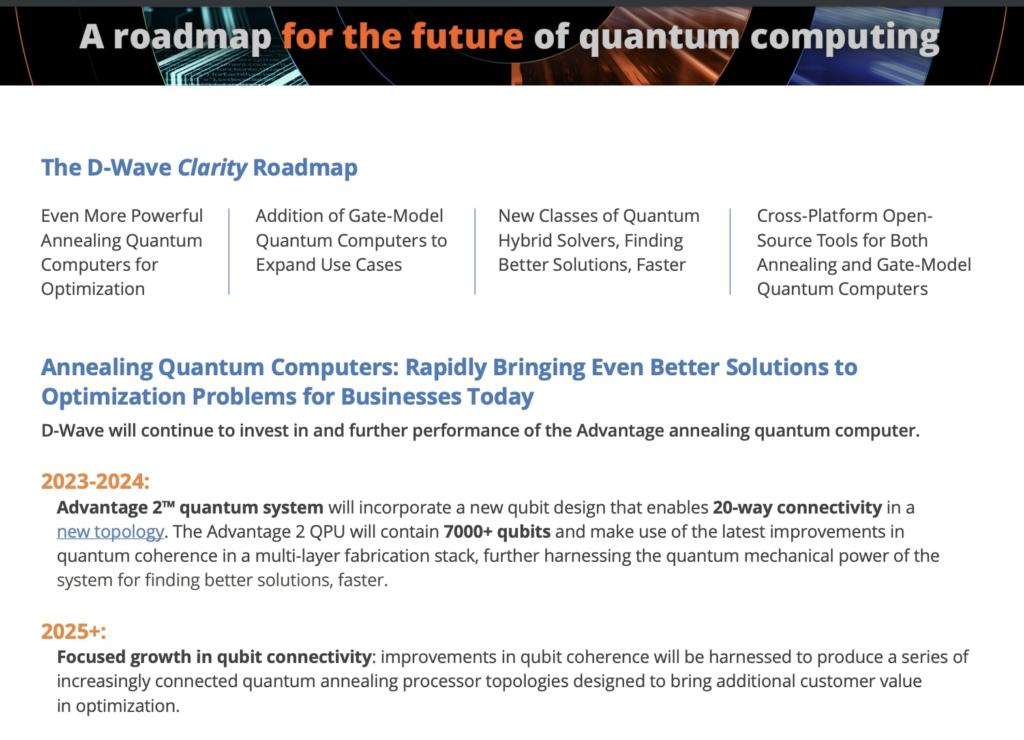D-Wave Systems revealed their next-generation quantum computing platforms will include both annealing and gate-model quantum computers. This is a significant shift because they were the pioneers in quantum computing but used something like an analog computer, called an annealer.
D-Wave is responding to major competition with billion-dollar valuations and hundreds of millions in funding. IonQ is publicly traded and is valued at $2.1 billion. IonQ uses trapped ions.
Honeywell’s Quantum computer division merged with Cambridge Quantum and is receiving hundreds of millions in funding from Honeywell. Honeywell also has a scalable trapped ion solution.
There are dozens of other quantum computer companies.
Here is D-Wave’s response. By 2023-2024, D-Wave will have a next-generation quantum annealer. The Advantage machine will have over 7,000 qubits, a new design and 20-way connectivity in a new topology. And starting next year, D-Wave Systems will have hybrid solvers that can solve mixed integer problems to help its users tackle more drug trial and chemical process optimization, logistics, scheduling and similar problems.
D-Wave has a new initiative to develop the industry’s first scalable and practical error-corrected gate-model computing system.
Currently, D-Wave sells a 5000+ qubit system with 15-way connectivity. The Advantage performance update will have a number of advancements that enable customers to solve larger and more complex problems with greater precision, finding better results 70% of the time on certain classes of problems.
D-Wave unveiled the constrained quadratic model (CQM) solver – the newest addition to D-Wave’s family of quantum hybrid solvers in Leap. The CQM solver incorporates problem constraints into the solver, allowing users to benefit from a simplified expression of their constrained problems. This significantly expands the breadth and size of problems customers can solve with constraints, allowing enterprises to formulate even larger problems that run across classical and quantum systems and find the best answers to complex business problems.

Gate-Model Quantum Computers: Expanding & Accelerating Quantum Solutions for Customers
D-Wave will apply its knowledge and nearly 20 years of experience in pioneering superconducting quantum annealing systems to build a scalable gate-model quantum computing technology in a multi-layer fabrication stack. Many efforts to develop gate-model quantum processors to date have focused on near-term success at the expense of scalability. In contrast, D-Wave is committed to focusing on the long-term vision of delivering a working technology at a scale that will bring value to industrial customers.
Phase 1:
Develop a gate-model qubit built in a multi-layer production stack, designed for scalability. Initially, D-Wave will validate and measure the multi-layer qubit design. Then the focus will be on verifying functionality of on-chip control devices for tuning and quantum logic using best practices developed in annealing quantum systems. The company will demonstrate the overall feasibility of qubit scalability to manage crosstalk and coherence issues for qubits near control devices.
Phase 2:
Demonstrate scalable logical qubits to deliver near-term engineering benefit and longer-term calculation benefit. Error-correction is a continuous tradeoff in which more physical resources increase the odds of a logical qubit surviving an error event. The target 60-qubit system will serve as a platform for validating on-chip, multiplexed control and the error-correction protocol in a single logical qubit.
Phase 3:
Demonstrate logical qubit manipulation. The target 1000-qubit system, to be fabricated on a single die, will be configurable as up to 4 error-corrected logical qubits. Developing scalable methods to control the interactions between logical qubits will be a critical step in preparation for the design of components for a full-scale gatemodel QPU.
Phase 4:
Develop scalable task-specific components. Much like a classical digital CPU, a fully functional gate-model QPU will consist of many task-specific architectural components, including modules for state initialization, specific logic operations, data movement, and memory registers. Choosing to develop task-specific components earlier in the design process will lead to efficient control and improved scalability in the future.
Phase 5:
A general-purpose quantum processing unit (QPU). The modules developed in phase 4 will be combined on a quantum logic unit, that hosts things like memory, logic registers, shift registers, and state initialization tools. QPUs will be constructed by combining multiple quantum logic units. As user experience grows, the company anticipates rolling out successive generations of quantum logic units that are tailored to accelerate applications.

Brian Wang is a Futurist Thought Leader and a popular Science blogger with 1 million readers per month. His blog Nextbigfuture.com is ranked #1 Science News Blog. It covers many disruptive technology and trends including Space, Robotics, Artificial Intelligence, Medicine, Anti-aging Biotechnology, and Nanotechnology.
Known for identifying cutting edge technologies, he is currently a Co-Founder of a startup and fundraiser for high potential early-stage companies. He is the Head of Research for Allocations for deep technology investments and an Angel Investor at Space Angels.
A frequent speaker at corporations, he has been a TEDx speaker, a Singularity University speaker and guest at numerous interviews for radio and podcasts. He is open to public speaking and advising engagements.

